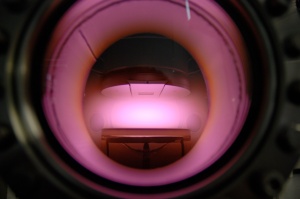Aug 29 2008
The secret of electron heating in low temperature plasmas has been discovered by the Bochum researchers at the Center of Excellence "Plasma Science and Technology" (CPST) at the Ruhr University - who have thereby found the answer to the question which has been puzzling scientists for decades of why particularly the electrons in such plasmas are so hot.
 Plasma reactor
Plasma reactor
The non-linear behavior of the boundary sheath causes the electric current flowing in the plasma to oscillate. This results in an increase of the electrical current, and thus in the heating of the plasma. This previously unknown mechanism called “non-linear electron resonance heating” is the subject of a report by researchers in the current issue of the world's foremost physics letters journal "Physical Review Letters", which will appear in print on Friday, Aug. 29.
Basic understanding after 30 years
With their research results the Bochum Electrical Engineers Dr. Thomas Mussenbrock and Prof. Ralf Peter Brinkmann (Institute for Theoretical Electrical Engineering at the Ruhr University of Bochum) together with colleagues from the University of California at Berkeley surrounding Prof. Mike Lieberman have contributed to basic understanding of so-called low temperature plasma, which has already been in industrial use for over 30 years. “Since the nineteen seventies vigorous technical debates have been in progress regarding the function of plasma, which, however, have not led to any conclusive results. In particular, we do not fully understand the exact energy coupling mechanism“, stated Thomas Mussenbrock. “Ever since plasma has been discovered and utilized, significant differences have existed between theoretical predictions on the behavior of the plasma and actual measurements.” The mechanism now discovered at the Ruhr University provides a new approach for explaining the heating mechanisms in low temperature plasma for the first time.
Versatile types of plasma
Without plasma, no Pentium: For example electrically excited gases can be used to form the structures on microchips by removing or depositing materials in the nanometer range. Today plasma-based processes already account for nearly one-half of all processing steps in the field of microelectronics. But plasma technology is not only essential here; it is also used in lighting, environmental and medical engineering. One of the particular characteristics of the low temperature plasmas used is the number of electrons contained with temperatures of over 10,000 degrees Celsius – in contrast to ions present as well as neutral atoms and molecules, which are comparatively cold at virtually room temperature . This thermal non-equilibrium is what initiates chemical reactions and other processes, making low temperature plasmas so versatile.
Key to specific utilization
The question of why the electrons could become so hot particularly at very low gas pressures, was not clarified completely up to this time. Researchers at CPST have now been successful in proving this “non-linear electron resonance heating” theoretically and experimentally. The basis of this mechanism is the intrinsic tendency of the plasma to oscillate. Excitation of a certain oscillation – starting from non-linear behavior of the plasma boundary sheath – causes a “self-excitation” of the oscillation in the electrical current flowing in the plasma. Theoretical studies have shown that non-linear electron resonance heating can more than double the efficiency of the energy coupling. Laboratory tests at CPST by Prof. Uwe Czarnetzki (Department of Physics and Astronomy) and Prof. Peter Awakowicz (Department of Electrical Engineering and Information Technology) have confirmed this result. The RUB researchers have simultaneously provided a new approach to understanding how plasma can be excited electrically for maximum efficiency. “Electron resonance can even be controlled specifically to initiate the mechanism”, according to Thomas Mussenbrock.